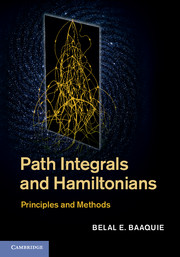Book contents
- Frontmatter
- Dedication
- Contents
- Preface
- Acknowledgements
- 1 Synopsis
- Part one Fundamental principles
- Part two Stochastic processes
- 7 Stochastic systems
- Part three discrete degrees of freedom
- Part four Quadratic path integrals
- Part five Action with acceleration
- Part six Nonlinear path integrals
- References
- Index
7 - Stochastic systems
from Part two - Stochastic processes
Published online by Cambridge University Press: 05 April 2014
- Frontmatter
- Dedication
- Contents
- Preface
- Acknowledgements
- 1 Synopsis
- Part one Fundamental principles
- Part two Stochastic processes
- 7 Stochastic systems
- Part three discrete degrees of freedom
- Part four Quadratic path integrals
- Part five Action with acceleration
- Part six Nonlinear path integrals
- References
- Index
Summary
A quantum entity is intrinsically indeterminate and is not in a determinate (classical) state when it is not being observed. The quantum entity is found to be in a determinate state only if an experiment is carried out to observe it, as discussed in Baaquie (2013e). The indeterminate behavior of the quantum entity is described by the formalism of quantum mathematics discussed in Chapter 2. The measure of quantum indeterminacy and uncertainty is Planck's constant ħ.
Randomness also exists in classical systems; however, a classical system's randomness is in principle different from quantum indeterminacy, since a priori, a classical random system is intrinsically in a determinate state. Classical randomness arises entirely due to our lack of complete knowledge of the determinate state. The theory of classical probability describes a classical system about which one has incomplete knowledge.
There are many ways of introducing randomness in a classical system, depending on its nature. A classical random system in thermal equilibrium is described by statistical mechanics. A classical system undergoing random time evolution can be described by taking the classical equations of motion and adding a random force to it. The evolution of the classical particle is then described by a stochastic process. The random force is usually represented by Gaussian white noise.
Classical random processes driven by white noise, such as those that arise in finance and other areas, form a wide class of problems that can be described by classical probability theory. It is shown in this chapter that the mathematical framework of quantum mechanics, and in particular, the Hamiltonian operator and path integrals, provide an appropriate mathematical formalism for describing processes that are driven by Gaussian white noise.
- Type
- Chapter
- Information
- Path Integrals and HamiltoniansPrinciples and Methods, pp. 125 - 158Publisher: Cambridge University PressPrint publication year: 2014
- 1
- Cited by



